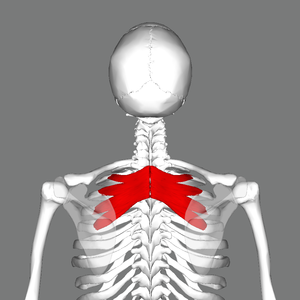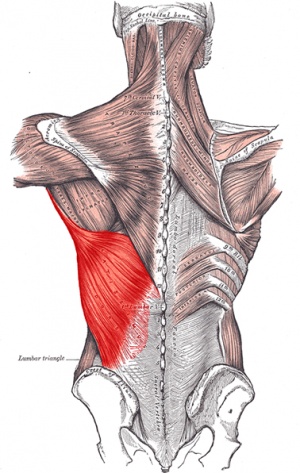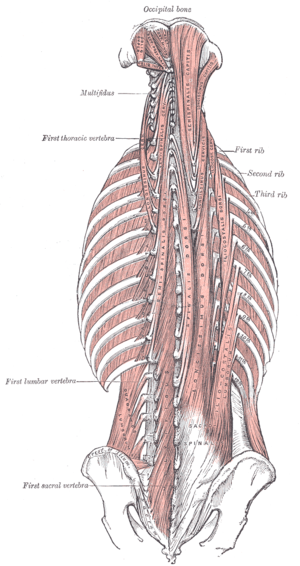Thoracic Spine Major Muscles: Difference between revisions
No edit summary |
No edit summary |
||
| Line 11: | Line 11: | ||
# Superficial back muscles - found just under the skin. Includes latissimus dorsi, the trapezius, levator scapulae and the rhomboids. Able to move the upper limb as they originate at the vertebral column and insert onto either the clavicle, [[scapula]] or [[humerus]]. | # Superficial back muscles - found just under the skin. Includes latissimus dorsi, the trapezius, levator scapulae and the rhomboids. Able to move the upper limb as they originate at the vertebral column and insert onto either the clavicle, [[scapula]] or [[humerus]]. | ||
#[[File:Serratus posterior superior muscle back.png|right|frameless]]Intermediate back muscles - work to elevate and depress the [[Ribs|rib]] cage. There are two major muscles within this category – the serratus posterior superior (see image R) and the serratus posterior inferior. | #[[File:Serratus posterior superior muscle back.png|right|frameless]]Intermediate back muscles - work to elevate and depress the [[Ribs|rib]] cage. There are two major muscles within this category – the serratus posterior superior (see image R) and the serratus posterior inferior. | ||
# | # Back muscles - Includes Erector Spinae and intrinsic back muscles. These are further subdivided into their own superficial, intermediate and deep layers. These muscles collectively work to help movements of the vertebral column and to also control [[posture]].<ref>Teachmeanatomy [https://teachmeanatomy.info/back/muscles/ Back Muscles] Available from:https://teachmeanatomy.info/back/muscles/ (last accessed 8.5.2020)</ref> | ||
== Major Muscles == | == Major Muscles == | ||
| Line 22: | Line 22: | ||
[[Rhomboids]] – these rhombus shaped muscles originate from the spinous processes of cervical and thoracic vertebrae (C7 to T5) and attach to the shoulder blade. The rhomboids main action is to pull the shoulder blades back (scapular retraction). | [[Rhomboids]] – these rhombus shaped muscles originate from the spinous processes of cervical and thoracic vertebrae (C7 to T5) and attach to the shoulder blade. The rhomboids main action is to pull the shoulder blades back (scapular retraction). | ||
'''2. Intermediate Layer:''' | |||
[[Serratus posterior|Serratus Posterior Superior]] – is a thin, quadrilateral shaped muscle, located at the upper and back part of the thoracic spine. It lies deep to the rhomboids and aids inspiration by elevating ribs 2 to 5 where it attaches. | [[Serratus posterior|Serratus Posterior Superior]] – is a thin, quadrilateral shaped muscle, located at the upper and back part of the thoracic spine. It lies deep to the rhomboids and aids inspiration by elevating ribs 2 to 5 where it attaches. | ||
| Line 27: | Line 29: | ||
[[Serratus posterior|Serratus Posterior]] Inferior – is located at the junction of the thoracic and lumbar regions. It originates from vertebrae T12 down to L3 and inserts into the 9th through to 12th ribs. It acts to draw the lower ribs backwards and downwards and assists in trunk rotation and extension. It also helps with forced expiration. | [[Serratus posterior|Serratus Posterior]] Inferior – is located at the junction of the thoracic and lumbar regions. It originates from vertebrae T12 down to L3 and inserts into the 9th through to 12th ribs. It acts to draw the lower ribs backwards and downwards and assists in trunk rotation and extension. It also helps with forced expiration. | ||
''' | '''3. Back Muscles''' | ||
Thoracic [[Erector Spinae]] – the main extensor (backward bending) muscle of the thoracic spine, located on either side of the vertebral column. Responsible for keeping the spine erect and helping to control forward and backward bending of the spine (flexion and extension). When acting unilaterally (on only one side of the body) it assists with side bending and spinal rotation to the same side. | 1.Thoracic [[Erector Spinae]] – the main extensor (backward bending) muscle of the thoracic spine, located on either side of the vertebral column. Responsible for keeping the spine erect and helping to control forward and backward bending of the spine (flexion and extension). When acting unilaterally (on only one side of the body) it assists with side bending and spinal rotation to the same side. | ||
[[File:Deep back muscles.png|right|frameless|566x566px]] | [[File:Deep back muscles.png|right|frameless|566x566px]] | ||
2. Intrinsic back muscles, named as such because their embryological development begins in the back, opposed to the superficial and intermediate back muscles which develop elsewhere and are therefore classed as extrinsic muscles | |||
[[Transversospinales|Transversospinalis Muscles]] – these shorter, deep muscles help stabilise the spinal segments. They are situated deep to the erector spinae, and run obliquely. They originate from transverse processes of inferior vertebrae and attach to spinous processes of superior vertebrae. Acting bilaterally (on both sides of the spine) these muscles produce segmental extension (backward bending of the spine) and stability. Acting unilaterally these muscles produce side flexion to the same side and rotation to the contralateral side (opposite side). These muscles (in order from superficial to deepest) are: | [[Transversospinales|Transversospinalis Muscles]] – these shorter, deep muscles help stabilise the spinal segments. They are situated deep to the erector spinae, and run obliquely. They originate from transverse processes of inferior vertebrae and attach to spinous processes of superior vertebrae. Acting bilaterally (on both sides of the spine) these muscles produce segmental extension (backward bending of the spine) and stability. Acting unilaterally these muscles produce side flexion to the same side and rotation to the contralateral side (opposite side). These muscles (in order from superficial to deepest) are: | ||
Revision as of 01:02, 9 May 2020
This article or area is currently under construction and may only be partially complete. Please come back soon to see the finished work! (9/05/2020)
Original Editor - Lucinda hampton
Top Contributors - Lucinda hampton and Kim Jackson
Introduction[edit | edit source]
The muscles of the back can be arranged into 3 categories based on their location:
- Superficial back muscles - found just under the skin. Includes latissimus dorsi, the trapezius, levator scapulae and the rhomboids. Able to move the upper limb as they originate at the vertebral column and insert onto either the clavicle, scapula or humerus.
- Intermediate back muscles - work to elevate and depress the rib cage. There are two major muscles within this category – the serratus posterior superior (see image R) and the serratus posterior inferior.
- Back muscles - Includes Erector Spinae and intrinsic back muscles. These are further subdivided into their own superficial, intermediate and deep layers. These muscles collectively work to help movements of the vertebral column and to also control posture.[1]
Major Muscles[edit | edit source]
1. Superficial Layer:
Trapezius – this large back muscle attaches to the vertebral column from the base of the skull to the ligamentum nuchae of the neck, to the spinous processes of C7 and the thoracic spine down to T12. It connects the shoulder blade with the vertebral column and acts to support the arm and assist in upper limb movement by controlling shoulder blade movements.
Latissimus Dorsi – this broad back muscle runs from the spinous processes of the lower thoracic vertebrae and lumbar spine, the connective tissue (fascia) of the thoracolumbar region, as well as the pelvis and lower ribs, to insert into the upper arm bone (humerus). Its primary action is to extend, adduct and internally rotate the upper arm (i.e. bring the upper arm backwards, to the side of the body and rotate the upper arm towards the body e.g. performing a chin up). It also influences movements of the shoulder blade and trunk.
Rhomboids – these rhombus shaped muscles originate from the spinous processes of cervical and thoracic vertebrae (C7 to T5) and attach to the shoulder blade. The rhomboids main action is to pull the shoulder blades back (scapular retraction).
2. Intermediate Layer:
Serratus Posterior Superior – is a thin, quadrilateral shaped muscle, located at the upper and back part of the thoracic spine. It lies deep to the rhomboids and aids inspiration by elevating ribs 2 to 5 where it attaches.
Serratus Posterior Inferior – is located at the junction of the thoracic and lumbar regions. It originates from vertebrae T12 down to L3 and inserts into the 9th through to 12th ribs. It acts to draw the lower ribs backwards and downwards and assists in trunk rotation and extension. It also helps with forced expiration.
3. Back Muscles
1.Thoracic Erector Spinae – the main extensor (backward bending) muscle of the thoracic spine, located on either side of the vertebral column. Responsible for keeping the spine erect and helping to control forward and backward bending of the spine (flexion and extension). When acting unilaterally (on only one side of the body) it assists with side bending and spinal rotation to the same side.
2. Intrinsic back muscles, named as such because their embryological development begins in the back, opposed to the superficial and intermediate back muscles which develop elsewhere and are therefore classed as extrinsic muscles
Transversospinalis Muscles – these shorter, deep muscles help stabilise the spinal segments. They are situated deep to the erector spinae, and run obliquely. They originate from transverse processes of inferior vertebrae and attach to spinous processes of superior vertebrae. Acting bilaterally (on both sides of the spine) these muscles produce segmental extension (backward bending of the spine) and stability. Acting unilaterally these muscles produce side flexion to the same side and rotation to the contralateral side (opposite side). These muscles (in order from superficial to deepest) are:
Sub Heading 3[edit | edit source]
Resources[edit | edit source]
- bulleted list
- x
or
- numbered list
- x
References[edit | edit source]
- ↑ Teachmeanatomy Back Muscles Available from:https://teachmeanatomy.info/back/muscles/ (last accessed 8.5.2020)









